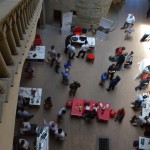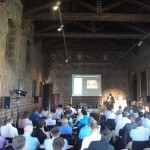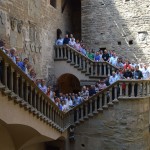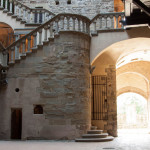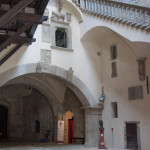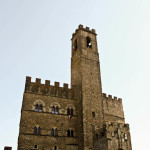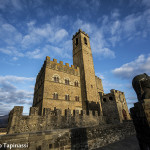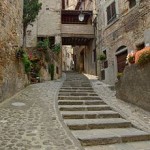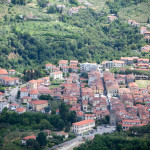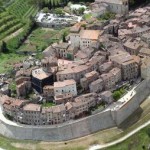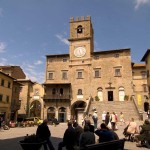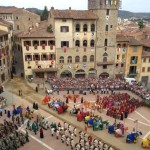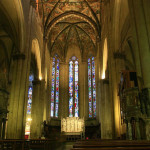Location
Following the great appreciation expressed by the participants of the past editions we are pleased to announce that THE CASTLE OF POPPI is going to host also the Third International Course on Geotechnical and Structural Monitoring.
The Castle of Poppi
The Castle of Counts Guidi is one of the most important examples of medieval architecture in the province of Arezzo.
The original nucleus of the castle consisted of the square tower that still dominates the rest of building and almost all valley. Current appearance of the tower, however, is not the primitive one, in fact it was transformed into a bell tower in the nineteenth century, during the restoration work following the damages suffered after a lightning strike. The tower had to be much higher and equipped with a projecting brackets apparatus, such as “Palazzo Vecchio” in Florence, of which the castle of Poppi seems to be a “prototype”. The authorship of the building is in fact uncertain: the oldest part is in part attributed to Lapo di Cambio, while the more recent one, dating to the late thirteenth century, would be his son’s, Arnolfo di Cambio, author of the “Palazzo Vecchio”.
The castle is today, except for the tower, as its medieval aspect was; the care and the strength with which it was built have allowed the excellent preservation of it.
Poppi
Poppi certainly is the most distinctive village and symbol of Casentino. Medieval center that still keep intact its walls, Poppi is placed at the top of a hill and its Castle of the Counts of the Guidi family dominates the village and a good part of the valley. The history of Poppi is closely linked to that of its family, one of the largest families of central Italy of the Middle Ages, which made Poppi the political and administrative capital of the Casentino (“Poppi, the capital of the Casentino valley” is written in the Giorgio Vasari’s fresco in Palazzo Vecchio, Florence).
Symbol of the village obviously is the Castle of the Counts Guidi, that stands at the top of Poppi; not less interesting are the numerous churches of the village, first of all, the one of San Fedele, which hosts a crucifix made by Giotto.
The village is still enclosed within the medieval walls, around which one can admire the beautiful view of the Tuscan countryside.
Thanks to its architectural and landscape beauty well preserved, which give still the flavor of the typical medieval Tuscan village, Poppi was recently included in the Club of the “most beautiful villages in Italy”.
Province of Arezzo
In the heart of Tuscany, on the border with Umbria, the province of Arezzo is a land rich in natural beauty and artistic worth to dedicate a journey to discover some of the most beautiful towns in Italy.
In particular, Arezzo (Aritim in Etruscan), described as one of the Capitae Etruriae (Etruscan capitals), is believed to have been one of the twelve most important Etruscan cities. In 311 BC Arretium was conquered by the Romans and from the 3rd to 4th century became an episcopal seat. Today, the ancient centre of the city retains all the fascination of its illustrious past. The principal buildings and monuments possess a wealth of Medieval and Renaissance art created by artists such as Cimabue, Piero della Francesca, Andrea della Robbia and Giorgio Vasari.
Others suggestive villages in the province of Arezzo are Anghiari, Castelfranco di Sopra, Cortona e Poppi.
Anghiari, in the valley of the Tiber river, is a land border between Umbria and Etruria and then between Tuscany and the Papal States. Inviolable, thanks to the powerful thirteenth century walls, enjoyed great importance throughout the Middle Ages.
This small village owes much of its fame to the historic battle of 29 June 1440, which saw opposing a coalition formed by the Florentine Republic, the Venetian Republic and the Papal States and the troops of the Visconti of Milan. The battle remained famous thanks to Leonardo Da Vinci’s masterpiece, “Battaglia di Anghiari”.
Along the route that linked Arezzo to Firenze is another historic village, Castelfranco di Sopra. Castelfranco has the urban layout of the Roman castrum, with the central square (and the most important orthogonal streets), designed by the great architect Arnolfo di Cambio. He was responsible for the Arnolfo tower, called “Porta Campana” (Bell Door), the only remaining tower, with carved out the Florentine lily and the date of construction, 1300.
The ancient village of Cortona is located to Mount Sant’Egidio, between the Valdichiana and the Tiber Valley. It contains within its walls a number of historical and religious buildings that testify the illustrious past and its importance in the history of the whole region. Nowadays Cortona is a town of 22,000 inhabitants that combines its past with thriving craft tradition, tourism and gastronomy.
Finally, Poppi certainly is the most distinctive village and symbol of Casentino. Medieval center that still keep intact its walls, Poppi is placed at the top of a hill and its Castle of the Counts of the Guidi family dominates the village and a good part of the valley. The history of Poppi is closely linked to this family which made Poppi the political and administrative capital of the Casentino (“Poppi, the capital of the Casentino valley” is written in the Giorgio Vasari’s fresco in Palazzo Vecchio, Florence). Thanks to its architectural and landscape beauty well preserved, which give still the flavor of the typical medieval Tuscan village, Poppi was recently included in the Club of the “most beautiful villages in Italy”.
Tuscany
Tuscany, land of more than 2000 years of history, inhabited by the mysterious Etruscans and the great Roman civilization, can be certainly defined the cradle of the Renaissance and the birth place of famous artists, writers and scientists of the past which left a historical, artistic and literary heritage unique in the world. That’s why this is one of the most favorite tourist destinations.
Both if you choose to enjoy the cultural heritage or the beautiful landscapes, Tuscany is the ideal place for an unforgettable holiday full of good food and good local wine. In Tuscany there are so many interesting things to see and do that sometimes it is hard to decide from what to start.
Florence, Siena and Pisa are among the favorite destinations, but the list of “cities of art” in Tuscany is much longer and includes Arezzo, Cortona, San Gimignano and Lucca, just to name a few.
